How to jump start a car in 9 steps
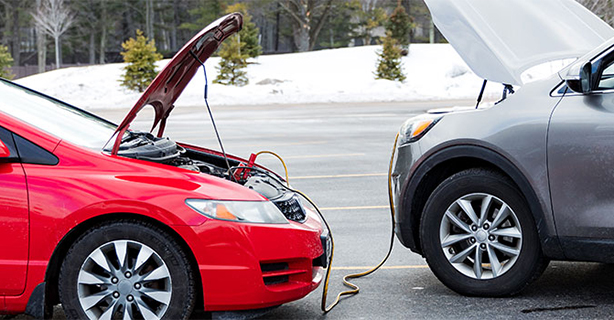
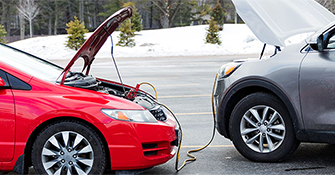
0 min. read
There are many reasons your car could need a jump start—from simple mistakes like leaving the lights on overnight to going weeks or months without driving it. Whatever your situation is, this guide will help you get back on the road quickly and safely. Explore Dairyland’s cheap car insurance options to find the coverage that fits your lifestyle and budget.
1. Set your car’s parking brake
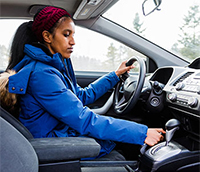
Before you do anything, secure your car by setting the parking or emergency brake to keep your car from rolling as you jump start it. This is especially important if you’ve parked on any kind of a hill or incline.
2. Check your owner's manual
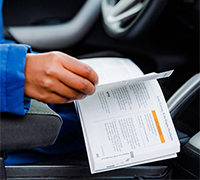
Your owner’s manual can help you locate the battery and provide additional jump starting tips. No two cars are the same—while most batteries are under the hood, some cars store their battery under the back seat or even in the trunk. The reason for these odd placements range from weight distribution to a simple shortage of space in the engine compartment.
Some cars have charging terminals under the hood even if the battery is elsewhere. Check your owner’s manual for specific instructions on jump starting your car.
3. Inspect the battery
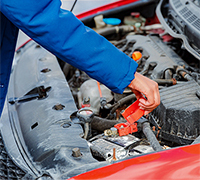
Once you’ve located your battery, inspect it for damage before attempting a jumpstart. Never attempt to jump a car with a damaged battery—this can start a fire, further damage the battery, and even damage other parts of the car that are expensive to repair.
Jump starting a vehicle is safe when done correctly, but before you do anything else, look for these signs of a damaged battery:
Cracked or leaking battery
A cracked battery can indicate improper usage or storage (such as extreme temperatures or driving on extreme terrain), or simply old age. You should replace your car battery every 3–5 years. The longer it’s in use, the higher the risk of cracks and leaks.
Frozen battery
A fully charged car battery freezes at around -80 degrees Fahrenheit, while a depleted battery can freeze at around 20 degrees Fahrenheit. This means a dead battery is significantly more likely to freeze than a fully charged battery. When a battery freezes, the water inside the cells expands, which can cause swelling or cracks in the casing or a short between the positive and negative plates.
Trying to jump start your car if the battery is frozen could lead to additional damage and even an explosion. If your battery is frozen, it needs to be replaced, not jumped.
Corrosion on the battery terminals
Battery corrosion is the result of sulfuric acid coming into contact with the terminals of your battery. This can be the result of overcharging, damage, or normal aging. Unless your battery is damaged or leaking, you can jump start a corroded battery. If possible, clean the terminals first, though this isn’t essential.
To remove corrosion from battery terminals, follow these simple steps:
Safety first: Wear gloves to prevent possible irritation and chemical burns.
Disconnect the battery cables from the terminals, starting with the negative cable and then the positive. Make sure the connectors don't touch the battery terminals at any point in this process.
Combine baking soda and water to prepare to wash the terminals. Since baking soda is a base, it neutralizes the acid on the corroded terminals.
Apply the baking soda solution with a towel or wire brush to remove the corrosion.
Rinse off any excess baking soda with fresh water.
Dry with a towel, then reconnect the cables.
4. Find someone with a charged car battery
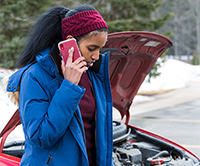
To give your car a jumpstart, you’ll need a booster vehicle—a vehicle with a charged battery. Start by contacting a nearby friend or family member. If you’re unable to find somebody you know, let someone know where you are and what’s going on before asking someone else that’s nearby for help.

See how we can help you stay safe on the road.
Get an auto insurance quote today.
5. Position the booster vehicle
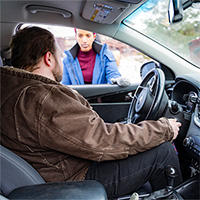
Have the booster vehicle’s driver position their vehicle so their battery and yours are as close together as possible. For most vehicles, that means you should position them hood-to-hood, but depending on your specific vehicle and situation, that might not always be possible or ideal.
If you aren’t able to position your vehicle hood-to-hood (for example, if you parked your vehicle in a space without front access), parking side-by-side may be your next best option. Whatever your situation, the important thing is to make sure your jumper cables can reach from one battery’s terminals to the other.
6. Gather tools and materials
Once you’ve positioned the vehicles so the batteries are as close as possible, gather the necessary tools and materials to begin jump-starting your car. You’ll want to have these items in your vehicle all the time, since you never know when you’ll need them.
Jumper cables
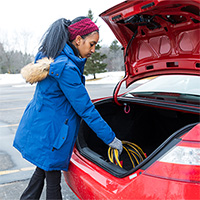
Jumper cables are the only truly necessary piece of equipment to jump start your car. While most jumper cables look similar, they’re not all equally suited to the job. Here’s what sets some cables apart:
Gauge. A smaller number describes a thicker, heavier-gauge jumper cable. Jumper cables can run the gamut from 1-gauge (heavy duty) to 12-gauge (light-duty). For most situations, a 4- or 6-gauge jumper cable is ideal for jump-starting a car.
Length. Along with gauge, length is the other big factor in choosing a jumper cable. A 10-foot cable is long enough for situations where you can position cars hood-to-hood, but 20–30 feet is ideal.
Flashlight
A flashlight—or the flashlight function on your cell phone—can help you locate the battery terminals under the hood, especially at night.
Gloves
Gloves can protect your hands from corrosion and electrical shock (which is unlikely, but still unpleasant). They also help keep your hands clean as you deal with engine grime, grease, and dust.
7. Connect the jumper cables
Be sure to connect the jumper cables in the correct order. Incorrectly connected jumper cables can damage your car’s electrical components, blow fuses, and irreversibly damage your car’s battery and the booster vehicle’s battery.
In addition to damaging the car, incorrectly connected cables are dangerous. Reversing the polarity of cables causes a surge of electricity that can cause sparks and even melt the jumper cables.
While you connect the jumper cables, never let the positive and negative clamps touch.
This is the correct way to connect jumper cables:

Connect the red (positive) jumper cable clamp to the positive (+) terminal on the dead car’s battery.

Connect the positive clamp to the positive terminal on the booster car.

Same car, other cable. Connect the black (negative) clamp to the negative (-) terminal on the booster car.

Connect the last negative clamp to a piece of exposed, unpainted metal (like a bolt or a bracket) on the dead car.
8. Jump start the car
Once you’ve properly connected both vehicles, you’re ready to give your car a jumpstart.
Start the booster vehicle
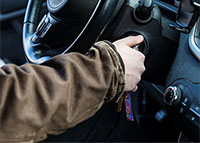
First, start the booster vehicle. A running engine generates electricity that charges the car’s own battery. When jumper cables are attached, this electricity is shared between the booster and recipient cars’ batteries.
Let the booster car idle
When a car battery is only slightly depleted, you may be able to start the dead car almost immediately. But for most cases, let the booster car idle for a few minutes to charge the dead car’s battery.
Start the dead car

After you’ve given the battery some time to charge, try starting the dead car. If it still clicks when you turn the key, it may still need more time to charge (even if the lights and radio turn on).
Under normal conditions, jump starting your car should take around five minutes, but factors like cold weather can make the process longer.
9. Remove the jumper cables
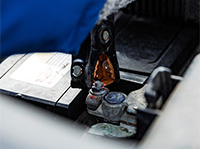
When you attached the cables, you followed a specific order. To remove jumper cables, follow the opposite order:
Remove black from metal on the dead car.
Remove black from booster.
Remove red from booster.
Remove red from dead.
While your car may be charged enough to start while connected to the booster vehicle, it’ll likely take at least 15 minutes of driving to fully charge your battery. When you remove the jumper cables, leave both cars running—the formerly dead car may not start again if it’s turned off too soon.
Once you’ve jump started your car, remember to release the parking brake before driving to avoid damage to the brake.
Like replacing a flat tire or changing oil, jump starting a car is a useful skill every driver should have. It can save you in a pinch and help you avoid an expensive tow truck ride to the mechanic for a simple fix.
Jump starting your car: FAQs
Can I jump start a car by myself?
Yes. While the easiest and most reliable way to jump start a car is by connecting to a booster car with jumper cables, devices like portable jumpstarters allow you to jump start your own car. Just keep in mind they can be expensive.
How long do I have to leave jumper cables connected?
You should leave jumper cables connected for around five minutes at first. If your car still doesn’t start after five minutes, it may take longer—up to 30 minutes in extremely cold temperatures. If after 30 minutes your car still doesn’t start, there’s likely more wrong than simply a dead battery. In that case, contact your mechanic.
Which terminal do I jump first on a car?
Remember the rhyme “red on dead.” Always connect the red (positive) terminal on the dead car first, followed by the positive terminal on the booster car, the negative (black) terminal on the booster car, and finally attach the negative clamp to unpainted metal like a bolt on the dead car.
La información general contenida en este blog tiene únicamente fines informativos o de entretenimiento. Vea el descargo de responsabilidad de nuestro blog.
*La exactitud de los datos está sujeta a la fecha de publicación de este artículo.







